-
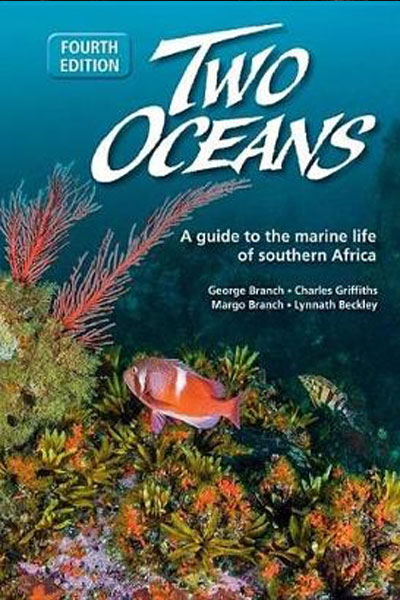 For over two decades Two Oceans has been the pre-eminent book to which scientists, students, divers, and beachcombers turn to identify and learn about marine life, from sponges to whales and seaweeds to dune forests. In this exuberantly colourful, fully revised fourth edition, over 2 000 species are now covered, names and other details have been updated to reflect the latest taxonomy and many new photographs have been added.
For over two decades Two Oceans has been the pre-eminent book to which scientists, students, divers, and beachcombers turn to identify and learn about marine life, from sponges to whales and seaweeds to dune forests. In this exuberantly colourful, fully revised fourth edition, over 2 000 species are now covered, names and other details have been updated to reflect the latest taxonomy and many new photographs have been added. -
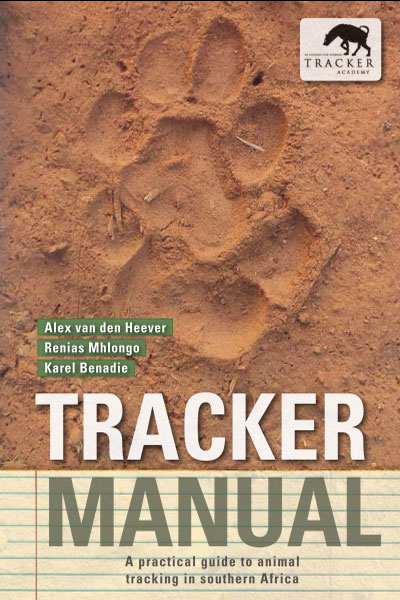 This practical guide to animal tracking is a one-of-its-kind manual, based on information developed with the help of southern Africa’s few remaining traditional trackers and their centuries-old wisdom in the field. It presents the more concrete and obvious wildlife signs for some 160 animals and teams them with a host of seemingly unrelated details to give a comprehensive picture of recent – and not-so-recent – traffic through the bush.
This practical guide to animal tracking is a one-of-its-kind manual, based on information developed with the help of southern Africa’s few remaining traditional trackers and their centuries-old wisdom in the field. It presents the more concrete and obvious wildlife signs for some 160 animals and teams them with a host of seemingly unrelated details to give a comprehensive picture of recent – and not-so-recent – traffic through the bush. -
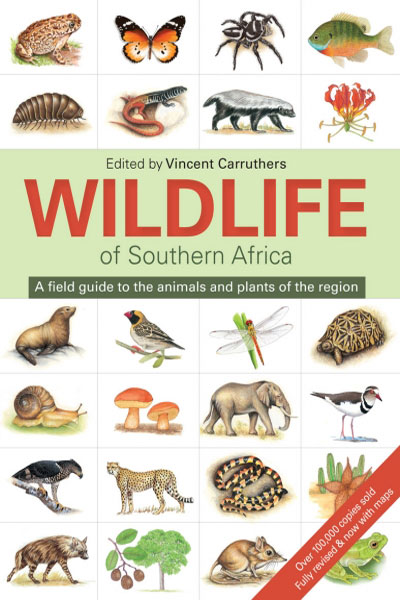 A field guide to the wildlife of southern Africa, describing over 2,000 plants and animals, with accurate illustrations in full colour. This book has been a trusted field companion for many years. Comprehensively updated, it now features range maps for most groups. The chapters are colour-coded for easy reference, and diagnostic features appear in bold type within the descriptions. Each chapter is written by a leading expert in the field. All the main plant and animal groups are covered: Lower invertebrates; Spiders and other arachnids; Insects; Freshwater fishes; Frogs; Reptiles; Birds; Mammals; Grasses, sedges, ferns, and fungi; Wildflowers; Trees.
A field guide to the wildlife of southern Africa, describing over 2,000 plants and animals, with accurate illustrations in full colour. This book has been a trusted field companion for many years. Comprehensively updated, it now features range maps for most groups. The chapters are colour-coded for easy reference, and diagnostic features appear in bold type within the descriptions. Each chapter is written by a leading expert in the field. All the main plant and animal groups are covered: Lower invertebrates; Spiders and other arachnids; Insects; Freshwater fishes; Frogs; Reptiles; Birds; Mammals; Grasses, sedges, ferns, and fungi; Wildflowers; Trees. -
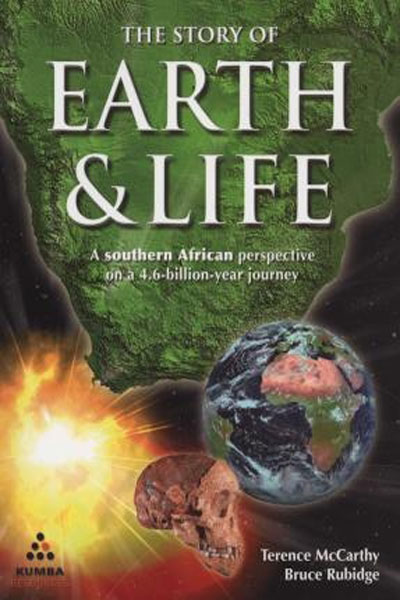 Southern Africa is without equal in terms of geology, a treasure trove of valuable minerals with a geological history dating back some 3 600 million years. In addition, the evolution of plants and animals, especially mammals and dinosaurs, is well preserved in the region, which also has among the best records of the origin of modern man.
Southern Africa is without equal in terms of geology, a treasure trove of valuable minerals with a geological history dating back some 3 600 million years. In addition, the evolution of plants and animals, especially mammals and dinosaurs, is well preserved in the region, which also has among the best records of the origin of modern man. -
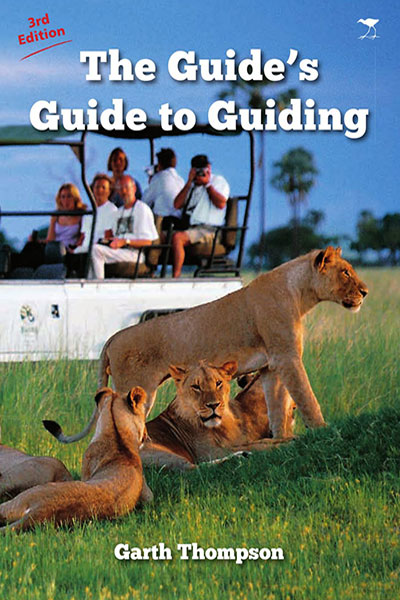 Guides Guide to Guiding Kindle Edition. The Guide's Guide to Guiding is written by veteran wildlife safari guide Garth Thompson and is aimed at informing and educating those that have a love and appreciation for the great outdoors – and a desire to share this passion with others.
Guides Guide to Guiding Kindle Edition. The Guide's Guide to Guiding is written by veteran wildlife safari guide Garth Thompson and is aimed at informing and educating those that have a love and appreciation for the great outdoors – and a desire to share this passion with others. -
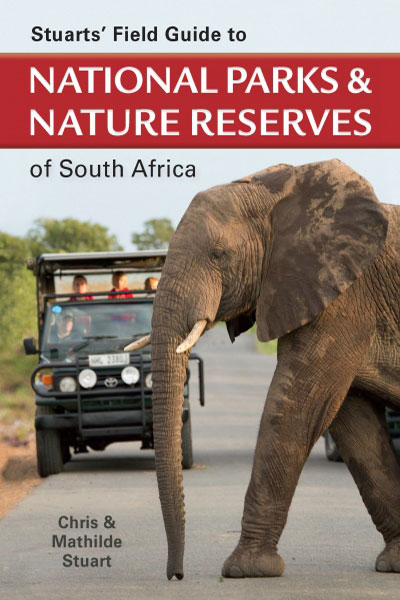 This book is a unique and indispensable guide to the hidden treasures of 43 of South Africa's best and most accessible national parks, nature reserves and wilderness areas. Included are more than 900 photographs, 140 detailed park, locator, provincial and vegetation maps, and a 31-page photographic guide that aids identification of wildlife and vegetation. Organised by province, the conservation areas are comprehensively described, covering history, location, landscape, geology, vegetation, and wildlife.
This book is a unique and indispensable guide to the hidden treasures of 43 of South Africa's best and most accessible national parks, nature reserves and wilderness areas. Included are more than 900 photographs, 140 detailed park, locator, provincial and vegetation maps, and a 31-page photographic guide that aids identification of wildlife and vegetation. Organised by province, the conservation areas are comprehensively described, covering history, location, landscape, geology, vegetation, and wildlife. -
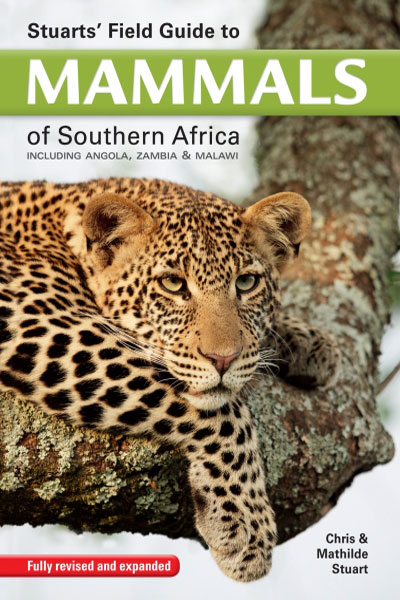 Greater southern Africa has a wealth of mammal species, almost 400 – all of which are covered in this fully updated, comprehensive field guide. Now expanded to include species found in Angola, Zambia, and Malawi, it has also been extensively revised to include: the most recent research and taxonomy, revised distribution maps and many new images.
Greater southern Africa has a wealth of mammal species, almost 400 – all of which are covered in this fully updated, comprehensive field guide. Now expanded to include species found in Angola, Zambia, and Malawi, it has also been extensively revised to include: the most recent research and taxonomy, revised distribution maps and many new images. -
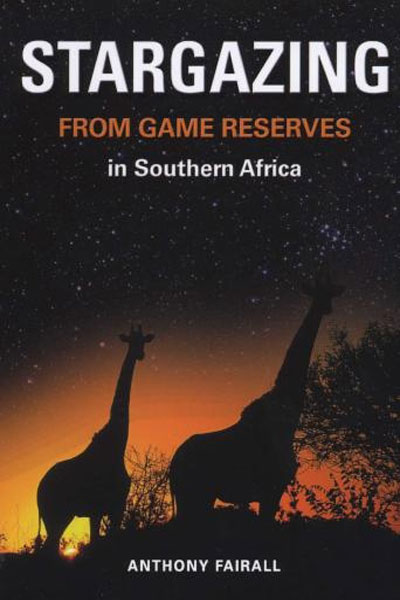 Stargazing from game reserves in Southern Africa offers visitors to game and nature parks an exciting night-time activity in the bush, giving them an opportunity to turn their binoculars skyward after dark.
Stargazing from game reserves in Southern Africa offers visitors to game and nature parks an exciting night-time activity in the bush, giving them an opportunity to turn their binoculars skyward after dark. -
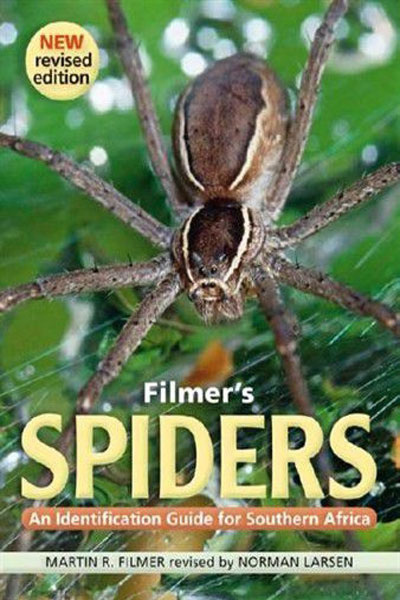 Fully revised and updated, Filmer’s spiders: an identification guide to Southern Africa features all 63 families of spider that occur in this region. A fresh layout, full-colour photographs throughout – many of them new – and diagrams of diagnostic features make this a quick and easy guide for use in the field. The spiders are grouped into web-living, ground-living, and plant-living species to aid identification.
Fully revised and updated, Filmer’s spiders: an identification guide to Southern Africa features all 63 families of spider that occur in this region. A fresh layout, full-colour photographs throughout – many of them new – and diagrams of diagnostic features make this a quick and easy guide for use in the field. The spiders are grouped into web-living, ground-living, and plant-living species to aid identification. -
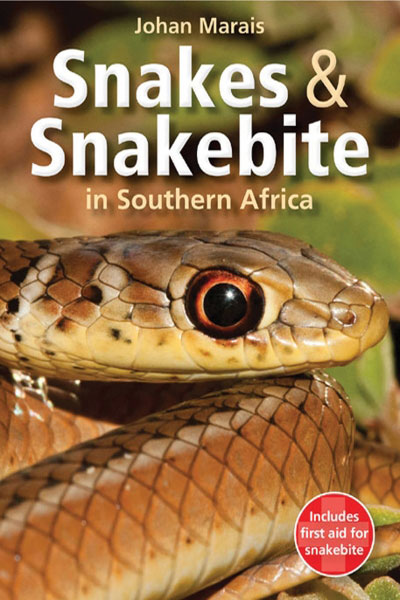 An essential guide to identifying all dangerous snakes and common harmless snakes in southern Africa, as well as quick and important practical advice on first aid measures in the case of snakebite. Simple icons, distribution maps, succinct text and numerous full-colour photographs assist with easy identification of snakes commonly encountered in the region. Symptoms and treatment of snakebites are described, providing the reader with vital first-aid information.
An essential guide to identifying all dangerous snakes and common harmless snakes in southern Africa, as well as quick and important practical advice on first aid measures in the case of snakebite. Simple icons, distribution maps, succinct text and numerous full-colour photographs assist with easy identification of snakes commonly encountered in the region. Symptoms and treatment of snakebites are described, providing the reader with vital first-aid information. -
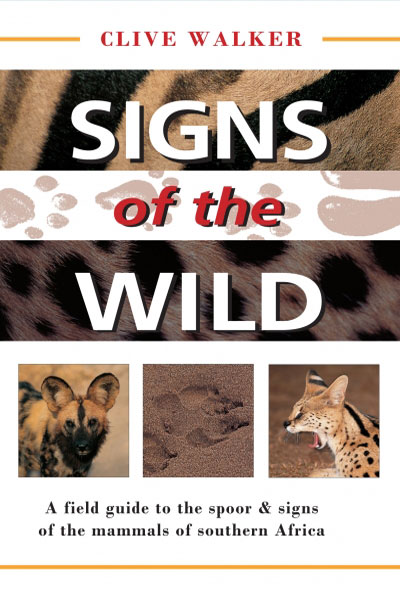 This compact field guide to the identification of Southern African mammals based on their spoor, droppings and skulls has been accepted as the standard work on the subject. This edition offers up-to-date information on identification through signs. This edition provides new illustrations for several species. It also features illustrations of skulls for all the carnivores.
This compact field guide to the identification of Southern African mammals based on their spoor, droppings and skulls has been accepted as the standard work on the subject. This edition offers up-to-date information on identification through signs. This edition provides new illustrations for several species. It also features illustrations of skulls for all the carnivores. -
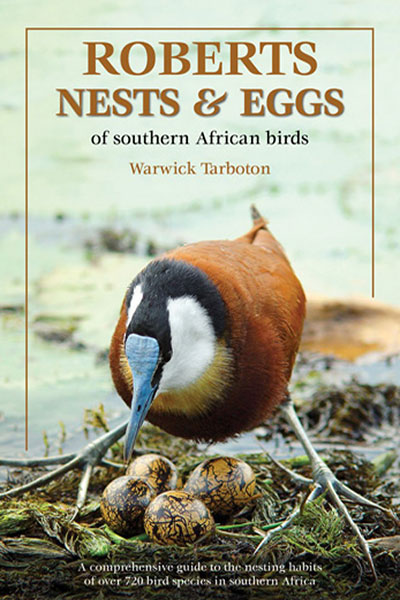 This new field guide deals with the nesting habits of the 730 bird species known to breed in southern Africa. It is set out in a standard field-guide format (text pages facing colour plates), covering 4–5 species per double-page spread. The information given is an up-to-date summary of what is known about the nesting habits of each species: where they nest, when they nest, what the nest looks like, how many eggs they lay, how long these take to hatch, etc.
This new field guide deals with the nesting habits of the 730 bird species known to breed in southern Africa. It is set out in a standard field-guide format (text pages facing colour plates), covering 4–5 species per double-page spread. The information given is an up-to-date summary of what is known about the nesting habits of each species: where they nest, when they nest, what the nest looks like, how many eggs they lay, how long these take to hatch, etc. -
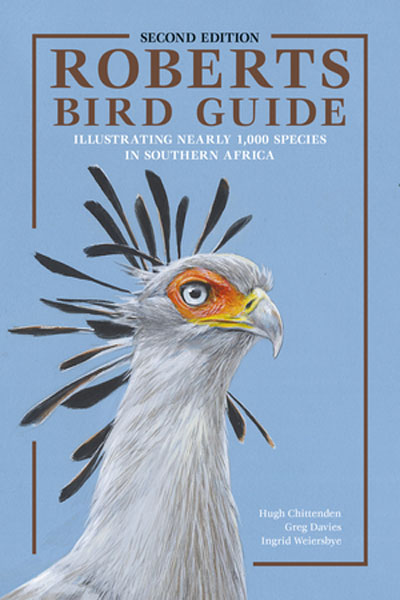 Covering nearly 1,000 species found in southern Africa (south of the Cunene and Zambezi rivers), this 570-page revised edition of Roberts Bird Guide features stunning new artwork detailing seasonal, age and sexual differences in approximately 240 annotated colour plates ...
Covering nearly 1,000 species found in southern Africa (south of the Cunene and Zambezi rivers), this 570-page revised edition of Roberts Bird Guide features stunning new artwork detailing seasonal, age and sexual differences in approximately 240 annotated colour plates ... -
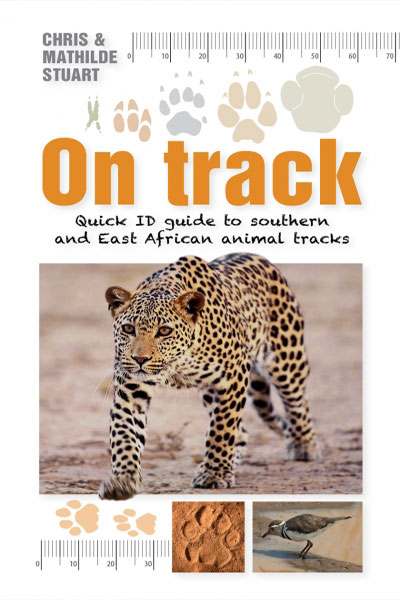 Following the success of the earlier Scatalog – Quick ID guide to southern African animal droppings, here’s another quick and quirky identification guide, this time to tracks of the region’s most commonly found mammals, but also includes tracks of reptiles, rodents, birds and insects. A simple key on the inside front cover directs users to any of 11 categories, such as ‘cloven hooves’, ‘paws’ or 'tramline-like trails. Nearly 100 animals or closely related groups of animals are depicted: for each, there’s a silhouette of front and back feet and a colour photograph of the track the average measurements for each track a short description of the track information about the circumstances and likely habitat Concise and to-the-point, this pocket-sized reference
Following the success of the earlier Scatalog – Quick ID guide to southern African animal droppings, here’s another quick and quirky identification guide, this time to tracks of the region’s most commonly found mammals, but also includes tracks of reptiles, rodents, birds and insects. A simple key on the inside front cover directs users to any of 11 categories, such as ‘cloven hooves’, ‘paws’ or 'tramline-like trails. Nearly 100 animals or closely related groups of animals are depicted: for each, there’s a silhouette of front and back feet and a colour photograph of the track the average measurements for each track a short description of the track information about the circumstances and likely habitat Concise and to-the-point, this pocket-sized reference -
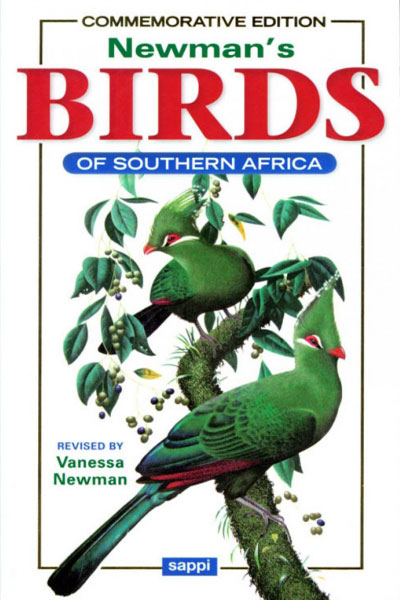 This commemorative tenth edition celebrates the contribution of the late author, Kenneth Newman, fully revised and updated by his daughter, Vanessa Newman, to reflect the latest research, taxonomy, and common names. Newman's Birds of Southern Africa, a leading field guide in the region, illustrates and fully describes all the birds recorded from the Antarctic to the Zambezi River.
This commemorative tenth edition celebrates the contribution of the late author, Kenneth Newman, fully revised and updated by his daughter, Vanessa Newman, to reflect the latest research, taxonomy, and common names. Newman's Birds of Southern Africa, a leading field guide in the region, illustrates and fully describes all the birds recorded from the Antarctic to the Zambezi River. -
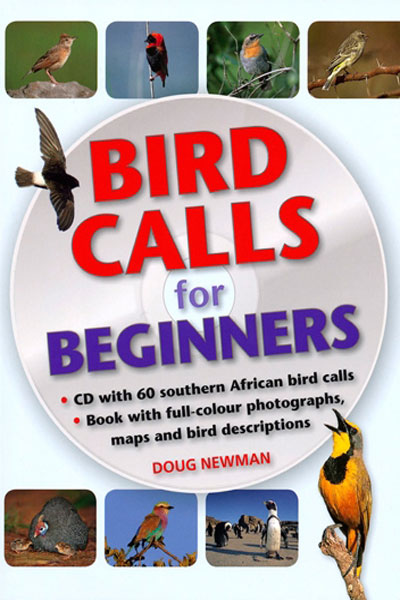 Bird Calls for Beginners, by Doug Newman features 60 common southern African bird calls; the book shows colour photographs of these birds, distribution maps and interesting text about their habits, feeding and nesting routines, and describes their calls.
Bird Calls for Beginners, by Doug Newman features 60 common southern African bird calls; the book shows colour photographs of these birds, distribution maps and interesting text about their habits, feeding and nesting routines, and describes their calls. -
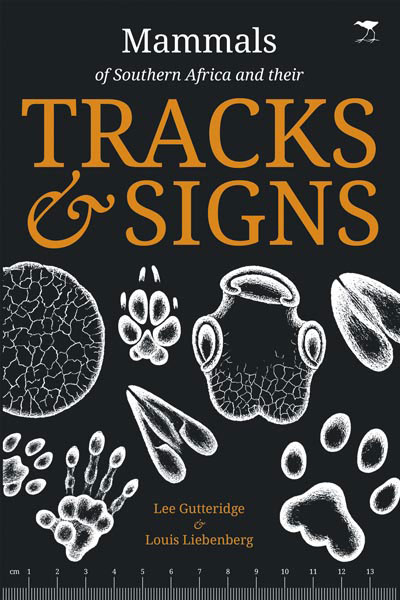 Tracking is a much-loved, yet difficult, subject that attracts at least some of the attention of almost every bush-goer who ventures into the wild places of southern Africa. The ability to accurately read difficult, partial, or little-seen signs left in the soil or sand is rare and largely the domain of professionals.
Tracking is a much-loved, yet difficult, subject that attracts at least some of the attention of almost every bush-goer who ventures into the wild places of southern Africa. The ability to accurately read difficult, partial, or little-seen signs left in the soil or sand is rare and largely the domain of professionals. -
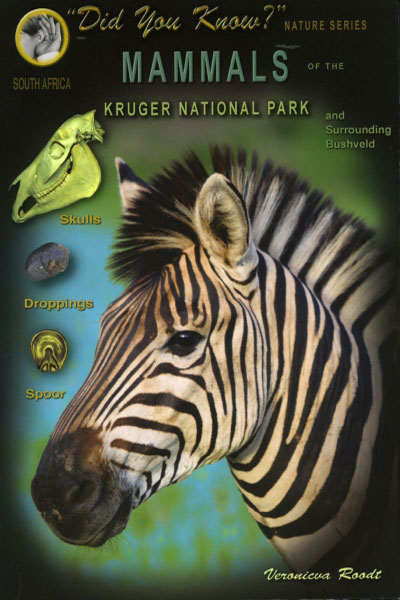 This compact guide to Mammals of the Kruger National Park and Surrounding Bushveld presents all the mammals you are likely to see in the region. Although handy in size, it packs in an astonishing amount of information, with each mammal accompanied by photos, distribution map, skull and dropping images, track illustration, a box giving ID pointers, and fascinating information on physiology, habits and behaviours.
This compact guide to Mammals of the Kruger National Park and Surrounding Bushveld presents all the mammals you are likely to see in the region. Although handy in size, it packs in an astonishing amount of information, with each mammal accompanied by photos, distribution map, skull and dropping images, track illustration, a box giving ID pointers, and fascinating information on physiology, habits and behaviours. -
 First published in 1986, Smithers' mammals are an authoritative and popular guide to the mammals of Southern Africa. This revised and updated edition incorporates the latest information brought to light by molecular genetics, while remaining accessible to the layperson and handy in the field. Each entry includes an in-depth species description; notes on habitat, behaviour, diet, and conservation status; accurate illustrations and spoor drawings; and a distribution map.
First published in 1986, Smithers' mammals are an authoritative and popular guide to the mammals of Southern Africa. This revised and updated edition incorporates the latest information brought to light by molecular genetics, while remaining accessible to the layperson and handy in the field. Each entry includes an in-depth species description; notes on habitat, behaviour, diet, and conservation status; accurate illustrations and spoor drawings; and a distribution map. -
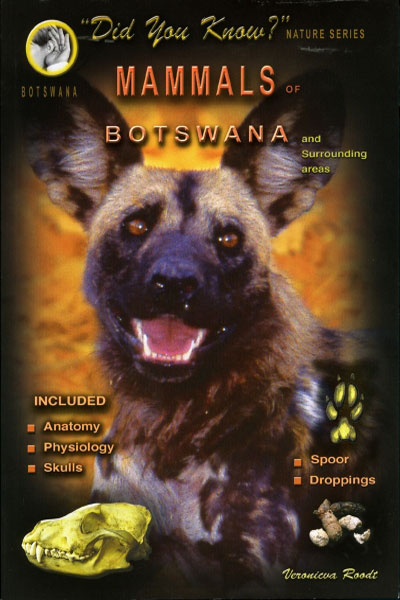 This guide to the mammals of Botswana offers a detailed roundup of more than 80 animals – with maps, travel information and a photographic field guide in a single, handy volume. It covers the six major mammal groups: non-ruminants, ruminants, carnivores, non-carnivorous small mammals, rodents and shrews, and bats – in colour-coded sections for quick reference, and with animal names in seven languages.
This guide to the mammals of Botswana offers a detailed roundup of more than 80 animals – with maps, travel information and a photographic field guide in a single, handy volume. It covers the six major mammal groups: non-ruminants, ruminants, carnivores, non-carnivorous small mammals, rodents and shrews, and bats – in colour-coded sections for quick reference, and with animal names in seven languages. -
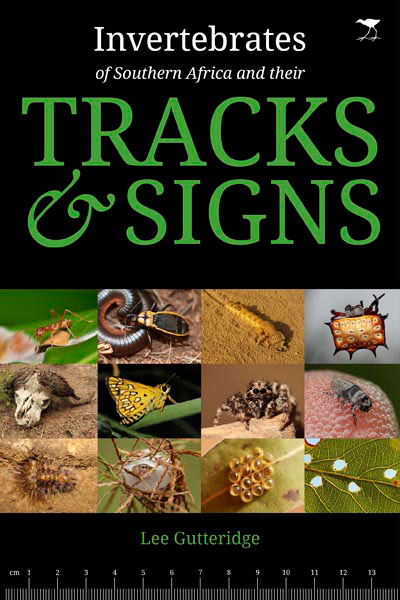 This book intensively covers a never-before-explored aspect of Southern African nature and is an essential new addition to the library of every nature lover. It was researched and written over the last four and a half years to open a door to a little-known micro-world that exists all around us. Invertebrates – which include commonly seen creatures such as butterflies, spiders, beetles, worms, and scorpions – are everywhere. The signs of their day-to-day activities are all around us if we know where to look. The life cycles and behaviours of many animals are discussed, with a special focus on interactions between mammals and invertebrates – a fascinating subject.
This book intensively covers a never-before-explored aspect of Southern African nature and is an essential new addition to the library of every nature lover. It was researched and written over the last four and a half years to open a door to a little-known micro-world that exists all around us. Invertebrates – which include commonly seen creatures such as butterflies, spiders, beetles, worms, and scorpions – are everywhere. The signs of their day-to-day activities are all around us if we know where to look. The life cycles and behaviours of many animals are discussed, with a special focus on interactions between mammals and invertebrates – a fascinating subject. -
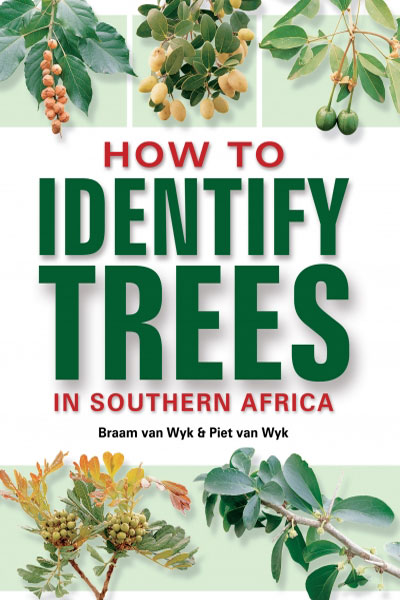 This book’s title says it all! Now in an updated second edition, it provides a clear understanding of how trees are constructed and what to look for when identifying a tree. The book is divided into two parts: • Part 1 describes and clearly illustrates the different parts of a tree and their role in tree identification. • Part 2 features a key to 43 tree groups, based on easy-to-observe stem and leaf features.
This book’s title says it all! Now in an updated second edition, it provides a clear understanding of how trees are constructed and what to look for when identifying a tree. The book is divided into two parts: • Part 1 describes and clearly illustrates the different parts of a tree and their role in tree identification. • Part 2 features a key to 43 tree groups, based on easy-to-observe stem and leaf features. -
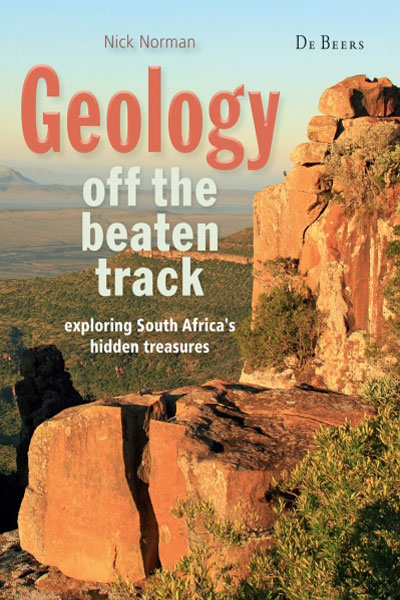 Geology off the beaten track follows on the success of author Nick Norman’s earlier Geological Journeys (co-authored with Gavin Whitfield), which has sold more than 20 000 copies in the last 6 years. This new book helps readers understand and interpret the geology along SA’s regional and other less-travelled roads. It features 13 detailed routes across the country, taking in geologically interesting areas such as the Richtersveld, Cape winelands and the Valley of Desolation near Graaff-Reinet. The text is richly illustrated with photos and explanatory diagrams, making it suitable for armchair travellers too. Maps for all the routes indicate key geosites, with GPS readings to pinpoint their location.
Geology off the beaten track follows on the success of author Nick Norman’s earlier Geological Journeys (co-authored with Gavin Whitfield), which has sold more than 20 000 copies in the last 6 years. This new book helps readers understand and interpret the geology along SA’s regional and other less-travelled roads. It features 13 detailed routes across the country, taking in geologically interesting areas such as the Richtersveld, Cape winelands and the Valley of Desolation near Graaff-Reinet. The text is richly illustrated with photos and explanatory diagrams, making it suitable for armchair travellers too. Maps for all the routes indicate key geosites, with GPS readings to pinpoint their location. -
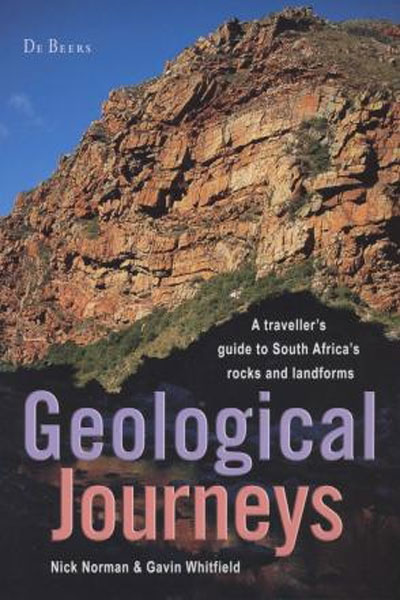 Geological Journeys: a traveller’s guide to South Africa’s rocks and landforms is an essential companion for car journeys. How often have we wondered about the jaunty tilt of a mountain ahead, the unusual patterns of a road cutting, the colour and texture of the roadside soil, or the purpose of a distant Minehead.
Geological Journeys: a traveller’s guide to South Africa’s rocks and landforms is an essential companion for car journeys. How often have we wondered about the jaunty tilt of a mountain ahead, the unusual patterns of a road cutting, the colour and texture of the roadside soil, or the purpose of a distant Minehead. -
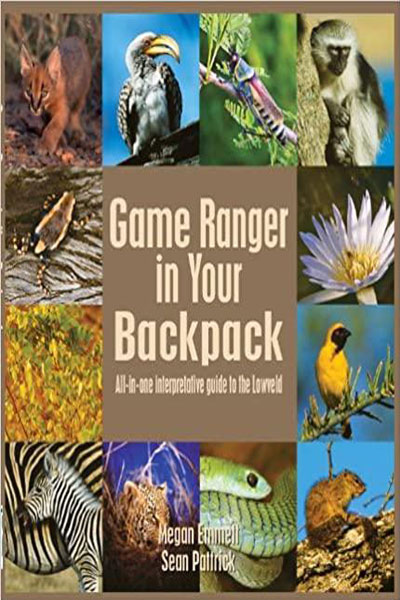 This guide is packed with practical, interpretative information on the most encountered animals and plants of the Lowveld - information that is usually only available if you have a game ranger or field guide by your side in the bush! It teaches people how to observe, identify and interpret what they see in the bush in a meaningful way, without having to wade through the reams of technical information found in most other field guides.
This guide is packed with practical, interpretative information on the most encountered animals and plants of the Lowveld - information that is usually only available if you have a game ranger or field guide by your side in the bush! It teaches people how to observe, identify and interpret what they see in the bush in a meaningful way, without having to wade through the reams of technical information found in most other field guides. -
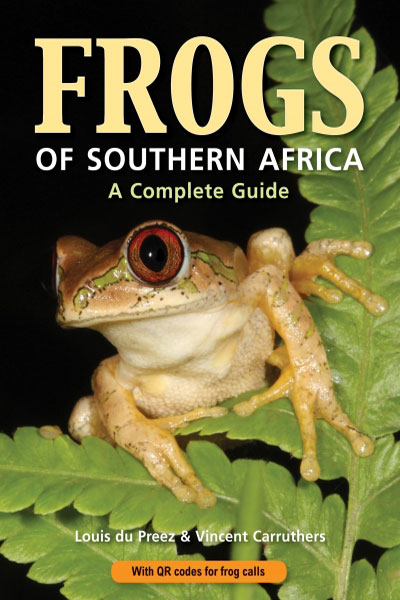 This new edition (with a slight name change) has been thoroughly updated to reflect taxonomic changes based on the most recent research and DNA studies and includes 12 new species and more than 130 new images. All 169 southern African frog species, and their tadpole stages, are fully described, along with their conservation status, calls, habitat, and habits.
This new edition (with a slight name change) has been thoroughly updated to reflect taxonomic changes based on the most recent research and DNA studies and includes 12 new species and more than 130 new images. All 169 southern African frog species, and their tadpole stages, are fully described, along with their conservation status, calls, habitat, and habits. -
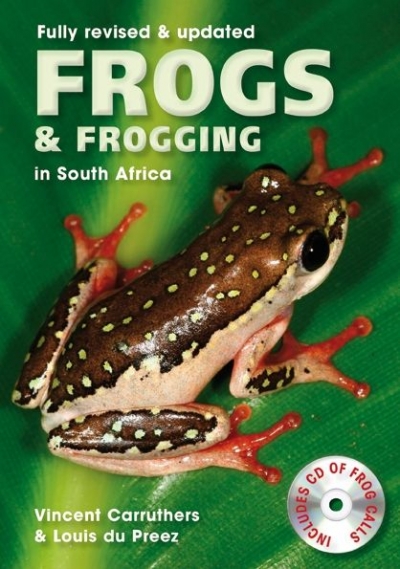 Frogs & Frogging in South Africa offers amateur froggers an accessible and practical introduction to frog identification. This edition of the highly popular guide has been expertly revised and fully updated to reflect the latest advances in taxonomy and nomenclature.
Frogs & Frogging in South Africa offers amateur froggers an accessible and practical introduction to frog identification. This edition of the highly popular guide has been expertly revised and fully updated to reflect the latest advances in taxonomy and nomenclature. -
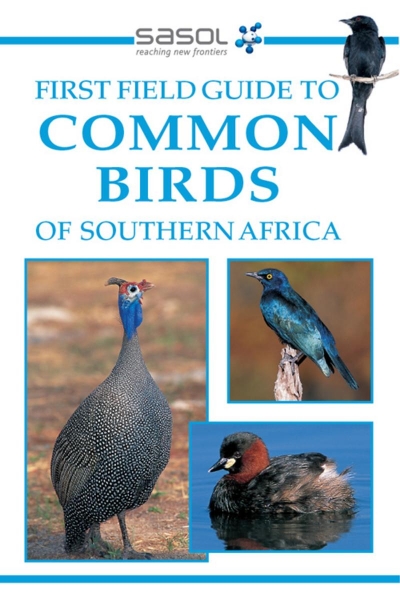
-
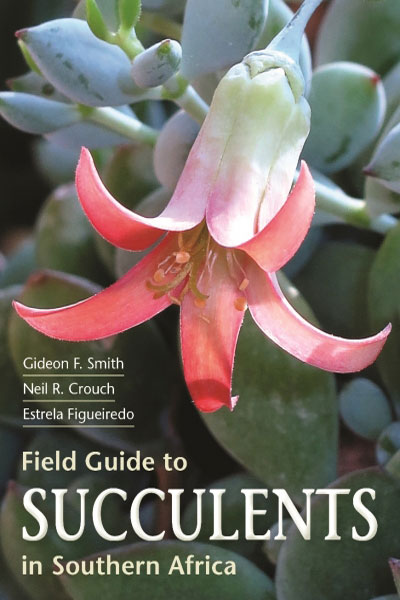 This user-friendly, richly illustrated field guide features more than 700 southern African succulents, focusing on the most interesting and commonly encountered species. An introduction to families and their key features will help readers identify the relevant plant group, while concise accounts describing the plants’ diagnostic features, along with distribution maps, will enable quick ID of species.
This user-friendly, richly illustrated field guide features more than 700 southern African succulents, focusing on the most interesting and commonly encountered species. An introduction to families and their key features will help readers identify the relevant plant group, while concise accounts describing the plants’ diagnostic features, along with distribution maps, will enable quick ID of species. -
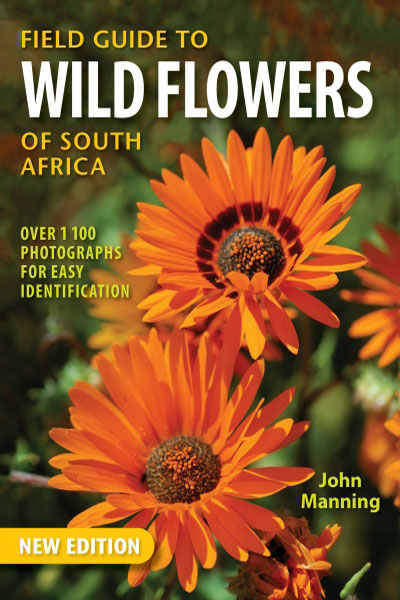 This fully updated edition of Field Guide to Wildflowers of South Africa covers more than 1,100 species of ore, focusing on the most common, conspicuous, and showy plants around the region. An informative introduction discusses plant diversity, vegetation types, and includes a key to identifying plant groups. The species descriptions follow, and each is accompanied by: a vivid photograph; a distribution map showing range, and an indication of the plant.
This fully updated edition of Field Guide to Wildflowers of South Africa covers more than 1,100 species of ore, focusing on the most common, conspicuous, and showy plants around the region. An informative introduction discusses plant diversity, vegetation types, and includes a key to identifying plant groups. The species descriptions follow, and each is accompanied by: a vivid photograph; a distribution map showing range, and an indication of the plant.

